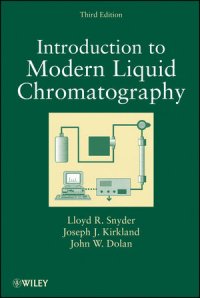
Ebook: Introduction to Modern Liquid Chromatography, Third Edition
- Year: 2010
- Language: English
- pdf
High-performance liquid chromatography (HPLC) is today the leading technique for chemical analysis and related applications, with an ability to separate, analyze, and/or purify virtually any sample. Snyder and Kirkland's Introduction to Modern Liquid Chromatography has long represented the premier reference to HPLC. This Third Edition, with John Dolan as added coauthor, addresses important improvements in columns and equipment, as well as major advances in our understanding of HPLC separation, our ability to solve problems that were troublesome in the past, and the application of HPLC for new kinds of samples.
This carefully considered Third Edition maintains the strengths of the previous edition while significantly modifying its organization in light of recent research and experience. The text begins by introducing the reader to HPLC, its use in relation to other modern separation techniques, and its history, then leads into such specific topics as:
- The basis of HPLC separation and the general effects of different experimental conditions
- Equipment and detection
- The column—the "heart" of the HPLC system
- Reversed-phase separation, normal-phase chromatography, gradient elution, two-dimensional separation, and other techniques
- Computer simulation, qualitative and quantitative analysis, and method validation and quality control
- The separation of large molecules, including both biological and synthetic polymers
- Chiral separations, preparative separations, and sample preparation
- Systematic development of HPLC separations—new to this edition
- Troubleshooting tricks, techniques, and case studies for both equipment and chromatograms
Chapter 1 Introduction (pages 1–17):
Chapter 2 Basic Concepts and the Control of Separation (pages 19–86):
Chapter 3 Equipment (pages 87–145):
Chapter 4 Detection (pages 147–197):
Chapter 5 The Column (pages 199–252):
Chapter 6 Reversed?Phase Chromatography for Neutral Samples (pages 253–301):
Chapter 7 Ionic Samples: Reversed?Phase, Ion?Pair, and Ion?Exchange Chromatography (pages 303–360):
Chapter 8 Normal?Phase Chromatography (pages 361–402):
Chapter 9 Gradient Elution (pages 403–473):
Chapter 10 Computer?Assisted Method Development (pages 475–498):
Chapter 11 Qualitative and Quantitative Analysis (pages 499–530):
Chapter 12 Method Validation (pages 531–567):
Chapter 13 Biochemical and Synthetic Polymer Separations (pages 569–663):
Chapter 14 Enantiomer Separations (pages 665–724):
Chapter 15 Preparative Separations (pages 725–755):
Chapter 16 Sample Preparation (pages 757–808):
Chapter 17 Troubleshooting (pages 809–877):